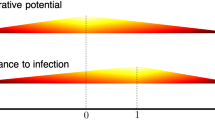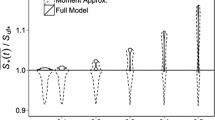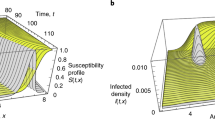Abstract
Continuous deterministic models are used to investigate the relationship between the epidemiology of endemic infectious disease and the genetics of natural selection in the host population when a specific genetic locus controls susceptibility to disease under a variety of circumstances. One locus, two allele genes are considered in the contexts of haploid and diploid host populations while the agent of infection is assumed to be invariant. It is found that polymorphic equilibria exist and are stable for certain parameter combinations in each of the cases studied. The equilibrium levels of gene frequencies and disease prevalence depend on both genetic and epidemic factors.
Similar content being viewed by others
References
Anderson, R. M., May, R. M.: Population biology of infectious diseases: Part I. Nature 280, 361–367 (1979)
Aron, J. L., May, R. M: The population dynamics of malaria. To appear in: Population dynamics of infectious diseases (R. Anderson, ed.), Chapman and Hall, Ltd., 1981
Bailey, N. J. T.: The mathematical theory of infectious diseases and its applications (2nd ed.). New York: Hafner Press 1975
Bremermann, H. J.: Sex and polymorphism as strategies in host-pathogen interaction. J. Theoret. Biology 87, 671–702 (1980)
Cooke, K. L.: Models for endemic infections with asymptomatic cases I. One group. Lecture notes, Lefschetz Center for Dynamical Systems, Brown University, 1979
Crow, J. F., Kimura, M.: An introduction to population genetics theory. Minneapolis: Burgess Publishing 1970
Friedman, M. J., Trager, W.: The biochemistry of resistance to malaria. Sci. Am. 244 (No. 3), 154–165 (1981)
Gillespie, J. H.: Natural selection for resistance to epidemics. Ecology 56, 493–495 (1975)
Hethcote, H. W.: Qualitative analyses of communicable disease models. Math. Biosci. 28, 335–356 (1976)
Hethcote, H. W., Stech, H. W., van den Driessche, P.: Stability analysis for models of diseases without immunity. J. Math. Biology 13, 185–198 (1981)
Jordan, D. W., Smith, P.: Nonlinear ordinary differential equations. Oxford: Clarendon Press 1977
Kemper, J. T.: The effects of asymptomatic attacks on the spread of infectious disease: A deterministic model. Bull. Math. Biol. 40, 707–718 (1978)
Kemper, J. T.: On the existence of superspreaders for infectious disease. Math. Biosci. 48, 111–127 (1980)
Lewis, J. W.: On the coevolution of pathogen and host: II. Selfing Hosts and Haploid Pathogens. J. Theoret. Biology (to appear)
Longini, I. M.: Models of epidemics and endemicity in genetically variable host populations, preprint
Author information
Authors and Affiliations
Rights and permissions
About this article
Cite this article
Kemper, J.T. The evolutionary effect of endemic infectious disease: Continuous models for an invariant pathogen. J. Math. Biology 15, 65–77 (1982). https://doi.org/10.1007/BF00275789
Received:
Issue Date:
DOI: https://doi.org/10.1007/BF00275789




